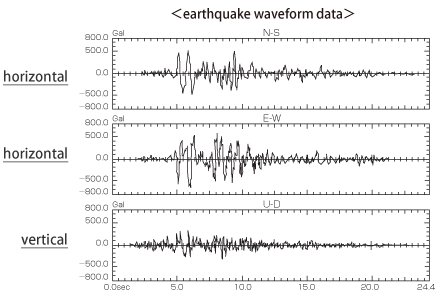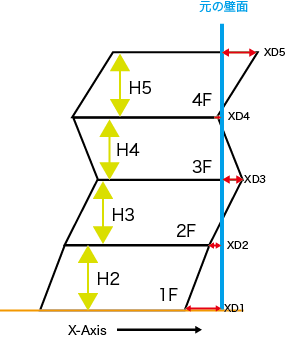章节1
基础知识
1.表示地震大小的单位
振动频率
振动频率是对每秒钟发生的周期数的测量。地震的主要频率成分小于10Hz,其垂直波比水平波的频率高。
加速度
980Gal=980cm/s2≒1G 日本曾经发生过所谓的 “特大地震”,阪神、中越和东北地区记录到了超过1000Gal的波形,很明显,这些地震产生的加速度大于重力加速度(1G)。980Gal=980cm/s2 ≒ 1G
Gal
加速度的单位,1Gal=1cm/s2,在地震学领域广泛使用。”Gal “被归类为非SI(国际单位),有其局限性。然而,它被允许在重力加速度或地震相关事务中自由使用。
震级
震级是指从焦点处测量地震的大小。一般来说,震级越深、越大,振动就越大。

- 震中越深,传播越广.
- 不同的震源深度有不同的表面强度,即使震级相同。
日本的地震烈度表
目前,日本气象厅使用新道来测量地震强度。地震烈度表是根据地面加速度的波形计算出来的。计算后的地震烈度表可能会根据地震持续时间和振动情况而改变。
见图表
日本气象局制定的数值是在阪神/淡路大地震后重新评估的。它分为10个等级;0-4、5-下、5-上、6-下、6-上、7。每个国家使用不同的地震等级。
| JMA 地震等级 | 测量的强度 | 人类的感知和反应 | 公用事业和基础设施 |
|---|---|---|---|
| 0 | 小于0.5 | 所有或大多数人都感觉不到 | – |
| 1 | 0.5~1.5 | 在室内只有部分人感觉到 | – |
| 2 | 1.5~2.5 | 许多人在室内感觉到。一些人醒着 | – |
| 3 | 2.5~3.5 | 许多人在室内感觉到. 一些人受到惊吓. |
– |
| 4 | 3.5~4.5 | 许多人受到惊吓。有些人试图逃离危险 | – |
| 5-低 | 4.5~5.0 | 大多数人试图通过跑出去逃避危险. 有些人觉得移动很困难. |
带安全装置的燃气表被跳闸,停止了同一家庭的燃气供应。在极少数情况下,可能会出现暂停供水的情况 |
| 5-上 | 5.0~5.5 | 许多人受到相当大的惊吓,认为难以移动。 | 到户的供气管道和主要水管被损坏. |
| 6-低 | 5.5~6.0 | 难以保持站立. | 到户的供气管道和主要水管被损坏. |
| 6-上 | 6.0~6.5 | 不可能保持站立,根本无法移动. | 通往当地小区的燃气管道和配水设施被损坏 |
| 7 | 6.5~ | 被摇晃甩出,无法随意移动 | 大范围内可能停止供水和供电 |
2.SI值
SI值
“速度反应谱 “是表达地震对结构的破坏力的标准之一。如果结构具有高刚度,速度正常周期在1.5-2.5秒之间。综合值(频谱分布的面积)可以作为代表地震破坏力的因素之一。因此,它被称为 “谱系强度:SI值”。
SI值是评估地震的标准
结构的破坏力。
为什么需要SI值?
-
即使是在相同的加速度或震级下,由于频率范围或时间的不同,对建筑物的破坏也会有所不同。传统的地震监测系统仅凭加速度(Gal)是无法估算出结构的实际损害的。
因此,应该用数值来了解结构的真实破坏情况。 -

与长冈市自来水局和大宫市煤气自来水局相比
大宫市的煤气自来水局在地震中受到冲击时,尽管加速度很高,但却没有任何损伤。
在长冈市,尽管加速度很低,但SI值却很高。
低,SI值高,观察到巨大的损害
“燃气安全小组委员会报告的新泻县中越地震中燃气供应业务的损失摘要-2009年5月”
12家燃气供应商的地震强度等级超过了5级。地震发生后,只有柏崎燃气水务部因机构严重受损而停止供气。
图中显示的是各地地震仪监测和记录的SI和加速度值。
图1 各燃气部的损坏情况
| 地震强度 | 公司 | SI值 (Kine) |
损失情况 (Gal) |
损失情况 |
| 6 上 |
柏崎i 煤气和自来水部门 |
99* | 加贺美町999* 藤井 746 Kariwa1,000* |
约34,000间房屋停电 (恢复目标房屋:30, 978**) |
| 6 下 |
长冈水务局 (三岛) | 50 | 293 | 120间房屋的供应出现问题 (7月16日恢复) |
| Ojiya Gas & 水道部 | 23 | 323 | 没有损失 | |
| Jyoetsu 燃气水务部 (Kashiwazaki) | 73 | 444 | 81间房屋的供应出现问题 (7月18日恢复) |
|
| 5 上 |
北陆瓦斯部 (长冈 branch) | 46 | 527 | 没有损失 |
| Kanbara 燃气部 | 36 | 210 | 没有损失 | |
| 长冈 水道部 (Koshiji) | 38 | 258 | 没有损失 | |
| Shirane 燃气部 | 26 | 165 | 没有损失 | |
| Sakae 燃气部 | 24 | 174 | 没有损失 | |
| 5 下 |
三池煤气、水和污水处理设施 | 34 | 254 | 没有损失 |
| 川口建设部 | 18 | 217 | 没有损失 | |
| Uonuma 燃气水务部 | 9 | 145 | 没有损失 |
(SI值是每个气体机构测量的最大水平。)
*测量范围超过
**恢复的目标房屋是在减去不使用煤气的房屋数量之和后的计算金额。
不使用天然气的房屋数量和因地震而倒塌的房屋数量减去供气房屋的数量后的计算结果。
的房屋数量减去不使用燃气的房屋数量和因地震而倒塌的房屋数量之和后的计算结果。
3.构架
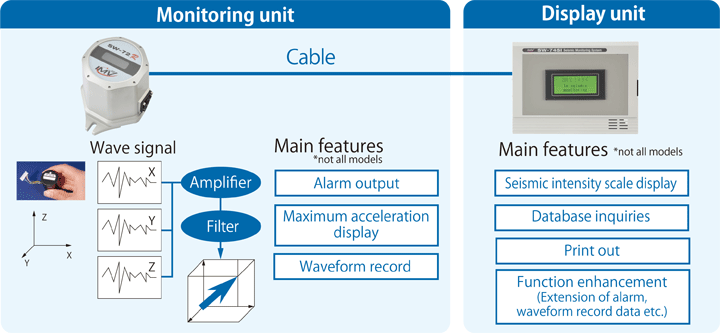
- 监测单元内有一个三维(XYZ)伺服拾音器和算术电路。
- 该监测单元执行从数字处理到报警显示的基本功能。
- 通过增加一个外部显示器,其功能可以扩展到基本报警之外。
4.传感器的原理
传感器一般分为两类:电动和机械类型。
IMV的所有地震监测系统都采用电动型传感器
电动式
伺服型

电气系统的典型原理。可以从线性信号的加速度中获得稳定的输出。
地震仪在三轴中加入了这个元素。
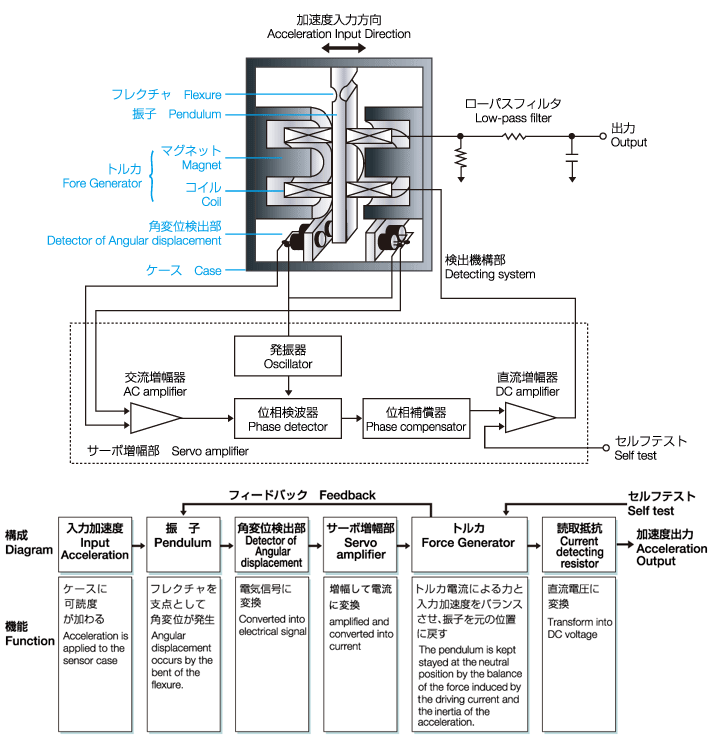
机械型
-
落球式
反应加速度值由钢球和接收器的尺寸比来设定。
缺点:还不能与直接地震兼容,最大级别不知道。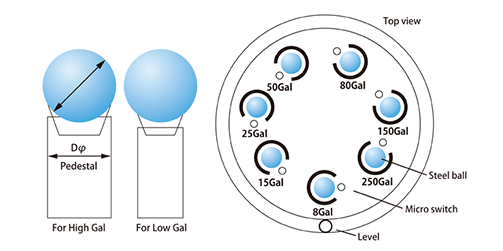
-
摆锤式
反应加速度值由接触器和测微器的尺寸比来设定
缺点:不符合直接地震的要求,最大水平不知道。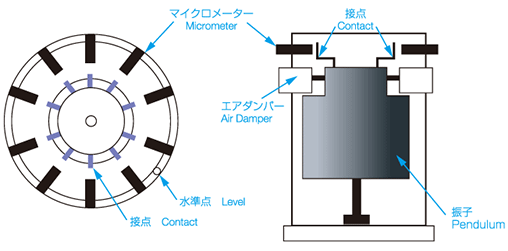
5.损失评估
损失评估
除了具有专业知识的人,其他人很难判断被地震破坏的结构是否可以继续使用(进入)。为此,正在努力利用地震观测的结果对此进行定量判断,并考虑将以下参数作为评估标准。
间歇性变形角
它是由地震引起的各层位移与各层高度的比率得出的。
在使用地震观测结果时,根据安装的传感器检测到的数据计算出位移量,然后与建筑层高进行比较,确定位移量。
需要注意的是,只有弹性变形产生的位移可以通过加速度传感器的数值来计算。当确定塑性变形时,需要伤针、阻尼器位移等。层间変形角的大小在建筑规范中被用作设计门槛。



